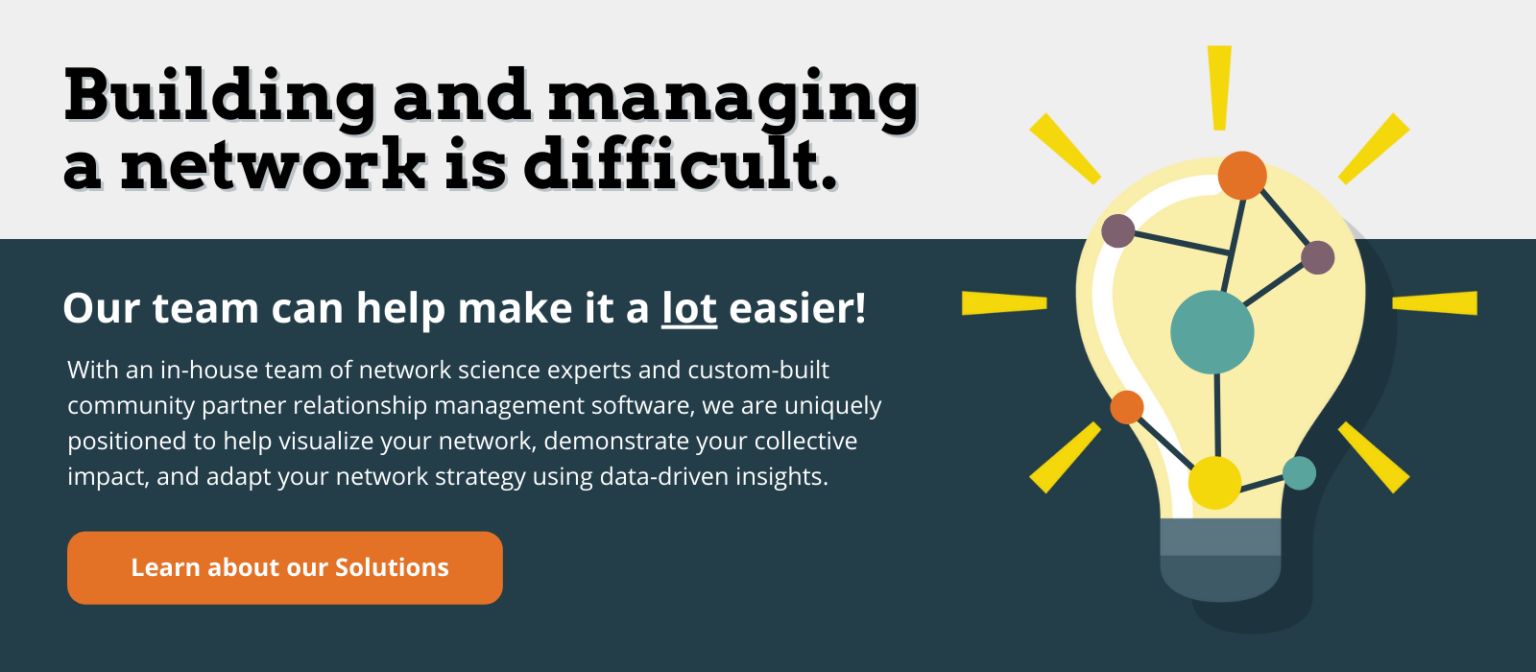
What is a Network Strategy? Why Is Having One So Important?
For those working in the field of social impact, building networks is part of the new normal. Creating partnerships with other organizations lets us share resources and knowledge, coordinate our action, and leverage diverse forms of value like influence and experience. However it is too often the case that networks form to tackle a complex issue without taking the time to carefully consider their network strategy. In fact, many networks don’t know what a network strategy is to begin with. In this article, we’ll walk you through the basics: What is a network strategy, why it’s so important, and how you can start designing one for your network.
Table of Contents
What is a Network Strategy? Our Definition...
A network strategy consists of your plan for building and managing a network of partners in a way best suited to meet your shared goals. It focuses on the considerations of HOW you’ll build your network, in terms of what you will do, and won’t do, to align your work with your goals. A well-thought out network strategy answers questions like:
- What type of network are you building?
- What is the network’s primary purpose, along with specific goals to evaluate progress?
- How will the network be governed, informally or formally, and by whom?
- What is the timeline for the network? Will it go on or end after meeting its goal?
- How will the network’s membership be selected and managed?

Get our monthly newsletter with resources for cross-sector collaboration, VNL recommended reading, and upcoming opportunities for engaged in the “network way of working.”
Why is a Network Strategy Important?
Creating or joining a network has costs: time, money, energy and other precious resources that could be spent elsewhere. If you aren’t carefully considering how to spend those resources in a way that maximizes your return on investment, your network approach could actually be very costly. Our research suggests that in extreme cases, taking a network approach with no concrete strategy could rob you of your collaborative advantage, leaving you less effective than you were beforehand.
For example, many networks get caught in a cycle of thinking “more is better,” in a network: more partners, more meetings, and more integration. In this situation, those leading the network continue to spend more and more time managing relationships, attending meetings, and sending emails, to the point that they struggle to get anything done. You cannot be all things to all people. Without a network strategy, you won’t be as effective a partner as you could be.
A Network Strategy Involves Many Components
A network strategy includes many different factors for consideration, including the network’s structure and type, membership and governance style, timeline, purpose, and more. Used together, they can help to frame a complete plan of action for your networks’s unique background, history and goals. So where should you get started? Here are five or six of the main considerations for creating a network strategy for your partnerships.
Starting with the Foundation: Network Goals, Types & Purposes
The term “network” encompasses many different types of networked organizations, each best suited for different goals and purposes. For example, coalitions and alliances are best suited for advocacy and policy change, while cohort and communities of practices are better for learning and information-sharing goals. Associations are membership-driven, serving the needs of member organizations, while regenerative networks are fluid and open-ended with fewer expectations of what specifically will be created.
If you don’t have a clear idea of what your network will accomplish, it’s impossible to pick a strategic network type. Consider whether you aim to better understand an existing problem or issue area, create new solutions and innovations, shares and disseminate best practices and data, or other unique goals. Each purpose is better served by different types of networks.
Who Are Your Partners? Network Membership Decisions.
A network is nothing without its members. Deciding who is and should be a member of your network can be a very complex task. Some networks have an informal membership, with partners coming and going without much management. Others have formal membership processes, with rules on who can join, a process for doing so, and former responsibilities that can include membership fees and required meeting attendance.
Often times a network falls somewhere in the middle of the spectrum, balancing the need to keep your network open and diverse with the desire to keep members accountable and invested. The most important question in this area is to be able to define clearly who is, and is not, a member of your network. This will make tracking your network in the future easier, as bounding a network can be very difficult later on.
Structuring Your Network Strategically with Network Science
The structure of a network consists of the way in which partners connect, both directly and indirectly. For example, dense, closed networks consist of many direct connections between partner – everyone knows and works with nearly everyone else. Alternatively, sparse, open networks have “structural holes,” gaps between partners, that force them to connect indirectly through intermediaries.
As I mentioned earlier, many networks aim to create a dense cloud of ties, believing that more partnership is better. In reality, this saps your energy and time very quickly. Healthy networks build a structure strategically, taking advantage of network concepts like sub-groups, weak ties, and bridging nodes that help you connect with more partners indirectly. This saves you time and money that can be used to build new partnerships, while still leveraging all the value your current partners provide.
Designing a strategic network structure is time-consuming and never totally finished, as new partners come and go. However it can make a transformational difference in how you work with your network, making it well worth the effort. The first step is to map your network to see how it exists today, and then begin making intentional changes to move it towards where you want it to be in the future.
Consider Your Network Timeline - Indefinite or Predetermined?
Some networks are created for a single time-based objective, like advocating for a policy change during a single legislative session, or serving as an advisory council for a new community-based initiative. Others do their work indefinitely, focused on problems that aren’t going away anytime soon like homelessness, health inequity, climate change or systemic racism. Being open about this from the very beginning is important or your long term success.
Be sure your partners are all aware and on the same page about the expected timeline for your network. If partners are unaware your collaboration has an end date, they may not be totally aligned with your work, and vice versa if you’re working indefinitely. Everyone in the network should be aware of the network’s intended lifespan to avoid unpleasant surprises down the road.
Governing the Network and Implementing Decisions
All networks require some level of governance – individuals or organizations managing the day-to-day activity of the network, making major decisions, and working to implement them. This ranges in two dimensions. First, network governance can happen within the network (self-governance) or from outside the network (board-governance). Internal governance is often best, allowing the network total autonomy, however external governance can help keep the network accountable, especially to those supporting their work.
Second, network governance can be unitary, exercised by just one or a small number of organizations (backbone-organization), or it can be shared, with most or even all organizations taking part in decision making activity. Shared governance often helps facilitate emergence – the development of new goals, ways of thinking, and innovations seemingly from random interaction among partners. However, a unitary governance model can increase coordination with a single individual accountable for much of the network’s operations. This often comes at the cost of strong network norms and diversity.
Get our free Network Strategy Guide!
Our Network Strategy worksheet includes all the main factors you should consider while creating a strategic plan for your coalition or network of community partners.
It includes a link to watch our complete video walkthrough of the worksheet with our CEO and Network Scientist, Dr. Danielle Varda, along with a PDF guide on how to fill out the worksheet.
Collect Network Data to Adapt Your Network Strategy
Once you have an idea of what kind of network you want to build, you need a way to track your progress and adapt your plans accordingly. Without solid data on your network’s structure, interactions and quality, it’s impossible to know what’s working, and what needs to be reconsidered. PARTNER is our community partner relationship manager, a system for tracking and mapping your network over time and translating your data into actionable insights for improvement.
PARTNER CPRM: Your Network Strategy Software Tool

PARTNER is an indispensable tool for planning, managing, and evaluating hub-and-spoke networks, providing valuable insights to guide strategic decision-making.
Get a Taste of PARTNER CPRM – Request a Demo Today!
If you’re keen to explore how PARTNER CPRM can enhance your network’s effectiveness, we encourage you to request a demo today! Experience firsthand how this tool can bolster your ability to manage, evaluate, and fortify your hub-and-spoke network.
What is a Network Strategy? The Last Word
A network strategy makes all the difference in creating effective collaboratives that help you reach your goals instead of tying up your time and energy. Taking the time necessary to think through each of this considerations in depth will save you a great deal more time later on in the process. For the best result possible, work with your partners closely to develop a network strategy to ensure it take into account varying perspectives and experiences, instead of just your own. Hopefully now you can answer the question yourself: :”What is a network strategy?” Best of luck designing one for you and your team!
Frequently Asked Questions (FAQs)
A network strategy is your comprehensive plan for forming, managing, and growing your network. It outlines methods and tactics for fostering effective collaboration and an overall network structure that meets your membership’s goals.
Key elements that define a network strategy include:
- Purpose and objectives
- Network structure and governance
- Membership and engagement
- Resource allocation and funding
- Tracking and evaluation
- Learning, adapting, and improving
A: A network strategy can be seen in many contexts, but a clear example lies in the field of public health. A local public health department might form a network strategy to address a community health issue, like obesity. This strategy could involve identifying key stakeholders (schools, healthcare providers, non-profits, food suppliers), defining the roles and responsibilities of each, setting common objectives, and outlining communication protocols. Then, they might use a tool like PARTNER CPRM to track relationships, visualize the network, measure shared impact, and inform ongoing strategic adjustments.
A: Strategic networking can yield multiple benefits:
Collaboration and Synergy: It facilitates collaboration and enables synergy by bringing together diverse entities with unique strengths and resources.
Shared Goals and Objectives: It aligns partners towards common goals and objectives, leading to more impactful outcomes.
Efficiency: It promotes efficient use of resources by enabling sharing and leveraging of assets within the network.
Learning and Innovation: It fosters learning and innovation as partners share knowledge, ideas, and best practices.
Resilience: It builds resilience by fostering interdependence and mutual support among partners, enabling the network to better adapt to change and withstand crises.
A: These terms refer to different types of professional networks:
Personal Network: This consists of relationships that offer individual support, guidance, and mentorship. It often includes friends, family, mentors, and colleagues. This network plays a crucial role in personal and professional development.
Operational Network: This network is primarily task-oriented. It comprises relationships built to accomplish work tasks and day-to-day operational duties. It includes teammates, coworkers, direct reports, and others with whom you collaborate regularly to complete projects.
Strategic Network: This network extends beyond day-to-day operational tasks. It involves relationships that provide new perspectives, strategic insight, and open up future possibilities. This could include leaders in your field, potential partners, or key stakeholders who can help you anticipate future challenges and opportunities.
A: A network-based strategy is a broader decision or plan that incorporates the concept of leveraging networks to accomplish wider organizational or community goals. It recognizes the value of networks and includes building, managing, or participating in networks as part of the strategy to achieve desired outcomes. For example, a non-profit organization might adopt a network-based strategy to amplify its social impact by forming partnerships with other organizations.
On the other hand, a network strategy is a more specific plan that focuses on how to build, manage, and leverage a particular network effectively. It outlines the mechanics of the network – who should be involved, how they should interact, how resources will be shared, and how the network’s effectiveness will be measured and improved over time. Using the earlier example, the non-profit’s network strategy would define who they partner with, how they’ll collaborate, share resources, communicate, and measure their collective impact. Both strategies recognize the power of networks, but the network strategy gets into the nuts and bolts of how to make the network work effectively.

Alex Derr, MPA
As Director of Marketing and Communications, Alex leads our website content creation, as part of his overall role creating and implementing our marketing and communications strategy. With real-world experience building and leading cross-sector coalitions for policy change, Alex focuses on helping others leverage network science to achieve more together.

Get our monthly newsletter with resources for cross-sector collaboration, VNL recommended reading, and upcoming opportunities for engaged in the “network way of working.”







